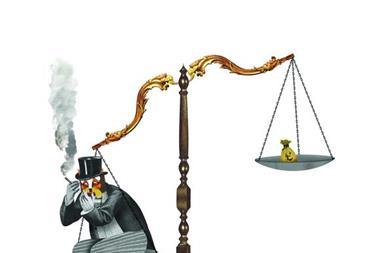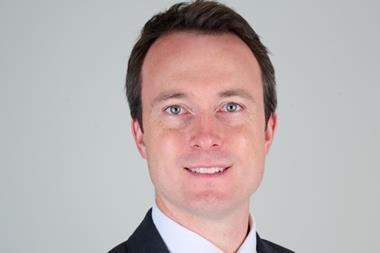We reveal this year’s top 50 listing and get under the skin of the chief executives of the uk’s biggest insurers. For the full ranking, download the pdf
No.1: Lloyd’s
www.lloyds.com
Chief executive Richard Ward
While Lloyd’s chairman Lord Levene travels the world as the ambassador for the 321-year-old market, chief executive Richard Ward is at home getting stuck into the business of persuading, cajoling and at times frogmarching it into the 21st century.
Ward is the younger of this formidable partnership, popular with the industry and respected as a great operational manager. He joined Levene at Lloyd’s in 2006 after 10 years at the International Petroleum Exchange (now ICE Futures), where he made his name as a moderniser, dragging oil brokers from the traditional open-outcry pit into the electronic age.
In his three years at Lloyd’s, Ward has succeeded where other chief executives have failed and has made impressive progress on the fight for electronic reform.
Longer term, he is focused on continuing the work of rehabilitating the market’s battered reputation, though he prefers to play down the significance of the radical strategic review by accountant Deloitte, due to report in January. Since the Lloyd’s Act opened the market to regional brokers last November, progress has been slow – Ward admitted in July that not a single one had yet signed up. “We don’t know what is going to happen in five to ten years’ time.”
He’s also involved in modernising insurance beyond the rarefied confines of One Lime Street, with a seat on the Insurance Industry Working Group that met with the Chancellor to produce the Vision 2020 report in July, seizing the national headlines by presenting a future in which the industry functioned as a sort of private welfare state.
In the news
Lloyd’s has weathered the credit crunch comparably well, and its popularity has soared. Earlier in the year, it said profits for 2008 had halved to £1.9bn in the wake of unprecedented trading conditions and Hurricanes Ike and Gustav. But in September, it triumphantly reported a near 40% leap in half-year profits to £1.32bn, and claimed its combined claims ratio was lower than all its competitors, at 91.6%.
There have been some significant personnel changes too – underwriting performance director Rolf Tolle retires at the end of the year. His replacement is Tom Bolt, formerly managing director of Marlborough Managing Agency and head of the European division of Berkshire Hathaway. But the most eagerly awaited news is the results of Deloitte’s review.
Broker view
Lloyd’s is still the first port of call for brokers trying to place difficult risks, and is generally regarded positively. The soft market doesn’t favour the London market, but it’s well-positioned for when the upturn comes.
No.2: Aviva
www.aviva.com
Chief executive Mark Hodges
Mark Hodges doesn’t officially become chief executive of Aviva’s general insurance business until 1 January, but he’s already made an impact, not least among the many brokers and consolidators who disagreed – in certain cases violently – with his predecessor Igal Mayer on the proper level of commissions. Mayer’s two years at the GI have been stormy, marked by conflict with distributors and thwarted ambitions to put rates on an upward track, though some concede his legacy is a more sustainable power balance. His outreach efforts to independent brokers have gone down a little better, but there’s no doubt the Canadian leaves many burned bridges as he jets back across the Atlantic to take over the North American business from retiring chief executive Tom Godlasky.
It will be Hodges’ job to rebuild those relationships, a task he’s well placed for. He has a reputation as a “good bloke” and is popular with brokers after a stint as managing director of the Norwich Union general insurance business, and seven years as its finance chief.
Hodges is one of Aviva’s homegrown talents. He joined after qualifying as a chartered accountant in 1991, has played a key role in many of the mergers and acquisitions that have formed today’s insurance giant and is now a board director reckoned as a natural successor to group chief executive Andrew Moss.
He became chief executive of the life business in April 2006, and for the past two years has formed the other half of a pincer movement with Mayer, stripping £450m of costs out of the insurance business by 2010. For all the bonhomie of this
avid rugby and Norwich FC fan – he is rumoured to be a driving force behind the shirt sponsorship deal – he’s had plenty of opportunity to show his ruthless side, sacking 100 senior managers and cutting the number of customer contact centres from 25 to nine.
Under his command, the general insurance and life businesses will be brought together. But that’s not a job for just one man, so the industry’s breath is bated in anticipation of promotions and senior appointments.
In the news
If it feels like the all-new Aviva has barely been off our television screens this year, the multimillion-pound rebranding must be working. Financially things were less rosy, with underwriting profits showing a steady drop over the past three years when bad weather and market conditions were taken out of the equation, and rows with consolidators knocking £1bn off its commercial premium, leading to attempts at rapprochement with brokers.
A series of high-level personnel changes have inevitably been linked to rows with the abrasive Mayer, with the brokers’ favourite, sales and marketing director John Kitson, announcing his retirement next March. He claims he wants to spend more time fishing, but that hasn’t stopped rumours that he’ll soon resurface. Most recently, of course, there’s been über-chief Andrew Moss’s affair with colleague Deidre Galvin, wife of European HR head Andrew Moffat, which hit the national headlines, prompting a statement of support from chairman Lord Sharman.
Broker view
Aviva’s relationships with the broking community have undoubtedly suffered in recent years, and it may struggle to regain lost market share as opportunistic competitors have rushed to fill the gaps. But it can still draw on a great store of goodwill in the market, something that its broker-focused television campaign will help.
No.3: The Royal Bank of Scotland
www.rbs.com
Chief executive Paul Geddes
Paul Geddes may preside over some of the most well-known brands in the market, with Direct Line, Churchill, Privilege and NIG, but he is a relatively mysterious figure, arriving this summer from the retail banking division of RBS. He took over from Chris Sullivan, who now runs RBS’s corporate banking division after a shake-up prompted by the clear-out of all the top brass who presided over the failure of the nationalised bank under Sir Fred Goodwin.
It may be the star of the pariah bank, but government ownership means RSBI is back on the market in the interests of competition. RBS has up to four years to sell or float the business.
Geddes will have to inject fresh energy – or at least keep the business ticking over until the sale or IPO. So far, he has restructured operations into two divisions handling claims and sales.
Oxford-educated Geddes is a marketing man, who was poached by RBS in 2004 after senior positions at a series of high-street names including Argos, Comet and Superdrug.
He has an able, no-nonsense reputation among marketers, steely in negotiations but also a gossipy regular at industry dinners. He always features in marketing “power lists”, steadily rising up the ranks. In 2007, he told Campaign magazine that his greatest achievement was losing four stone that year, his favourite album was ELO’s Out of the Blue and that the principle that defined his working life was: “There is always a solution.”
In the news
The fate of RBS’s general insurance arm is one of the biggest guessing games in the industry. Earlier this month, the forced sale was announced and the bidders began to line up. Meanwhile, it’s not been a good year financially for the insurance business. In August, it announced that operating profits for the first six months of the year fell 28% to £217m after an even larger drop in investment income, a rise in claims due to bad weather and the loss of the Tesco Personal Finance contract last December after 11 years.
Broker view
Brokers have little to do with the Direct Line and Churchill brands, but they do like NIG. However, all the sale rumours have created a great deal of uncertainty and many are still unsure that it’s a long-term bet.
No.4: AIG
www.aig.co.uk
Chief executive Lex Baugh
Lex Baugh won the admiration of the industry for his steadfast handling of the fallout of the AIG collapse in the States and the way he has piloted the UK general insurance business into much calmer waters. When the US government stepped in to shore up the giant in September 2008, the UK arm found itself in jeopardy as clients wondered whether to continue placing business – customer retention dropped from a percentage in the mid-90s to the mid-80s. Baugh has spent the past year tirelessly attempting to reassure the market of his company’s financial stability, abandoning its former closed-door policy to take the stage at conferences to answer tough questions and make the case again and again for the strength of the business.
It’s paid off: analysts at UBS have revised their predictions of lost market share from 25%-30% to just 17%-22%. That’s not bad for a business that has received $180bn (£110.3bn) in US state aid, has lost 10,000 staff (8.6% of the total) and half its senior management, and continues to labour under the heavy demands of government scrutiny.
Baugh, an unflappable American, has been with AIG for 26 years. He joined the property and casualty division of American International Underwriters (AIU) in 1983 as a financial lines underwriter and has worked for the company in New York, London and Paris. He describes his year-long journey out of corporate hell as a “purge” and “rebirth” that has allowed him to make some tough decisions. He’s become, he says, “a bit of an adrenalin junkie”.
Now all the general insurance businesses are being extracted from their complex ownership structures and brought into Chartis, a special purpose vehicle, and a dedicated GI firm with its own management. A stock market flotation is planned before the end of next year to pay back the US government’s investment. According to AIG’s latest results, its fortunes may be on the turn already. In August, it posted its first quarterly profit since 2007: a net income of $1.82bn. The industry at large believes this is down in no small part to Baugh’s management, his dignity and reputation if anything enhanced by the crisis.
In the news
AIG was the most high-profile insurance firm to be hit by the financial crisis, the one blot on the industry’s copy book and perhaps the exception that proves the rule, as its troubles came from a single subsidiary that was heavily embroiled in derivatives. Under greatest scrutiny has been its pay and bonus structure, with President Obama’s pay tsar Kenneth Feinberg finally okaying £12.1m worth of payments in October.
Broker view
There is a great deal of admiration for the way AIG has pulled back from the brink, but it still has a lot of work to do to restore credibility among clients. The rebrand may help but there is still some uncertainty over its long-term future.
No.5: RSA
www.rsagroup.com
Chief executive Adrian Brown
Among its competitors, RSA maintains a dignified, if sometimes lofty, silence on its plans, eschewing bold statements on commissions and rates that might create tension with distributors. But Brown himself is a much more voluble presence; chatty, fast-talking and rarely still. He took over as chief executive in September last year after 19 years with the company, two as chief operating officer and seven on the board. He headed up the formation of More Th>n in 2001.
RSA has recovered considerably from its basket-case reputation in the past seven years, taking a slow-but-steady approach to cost-cutting and improving efficiency under group chief Andy Haste that has stood it in good stead in recent, troubled months.
Brown has not really deviated from previous form – RSA has had a quiet year, apart from the announcement of 1,200 job cuts, 14% of its 8,700-strong workforce, by the middle of 2010 as part of a strategy to save £70m a year. The company’s cautious outlook has yielded better-than-average results under the circumstances and, contrary to what you might think from its silence, it has been raising rates longer than its competitors. When in the first six months of the year premiums were down 3% to £1.3bn and profits had dropped 24% to £301m, Brown promised action would continue.
He restructured the broker, retail and affinity businesses into two divisions, focusing on commercial and personal lines, and slimmed his management team. He’s also put a charm offensive to brokers on the to-do list in his ever-present little black book. To this end, RSA is to cut the 2,000-strong membership of its somewhat neglected Broker First network to get closer to favoured firms, and has promised to respond to brokers within three hours. It also made a multimillion-pound loan to Oval in September.
In the news
RSA’s management team is generally well regarded by the stock market, although its normally well-performing share price fluctuated at speculation in the autumn that it would raise up to £600m to go on the acquisition trail. Other than that, it’s been a quiet year as Brown’s restructuring changes work their way through. The most drastic news was the planned redundancy of 14% of its staff.
Broker view
Not an easy firm to do business with of late, RSA has lost out to competitors as it tried to lead a charge on higher rates to improve profitability. But it remains a solid and dependable insurer.
To find out the rest of the Top 50 Insurers, click: Top 50 Insurers 2009 Full Listing.
Downloads
Top 50 Insurers 2009 Full Listing
PDF, Size 0.16 mbTop 50 Insurers 2009 supplement pdf
PDF, Size 3.73 mb
Hosted by comedian and actor Tom Allen, 34 Gold, 23 Silver and 22 Bronze awards were handed out across an amazing 34 categories recognising brilliance and innovation right across the breadth of UK general insurance.













































No comments yet